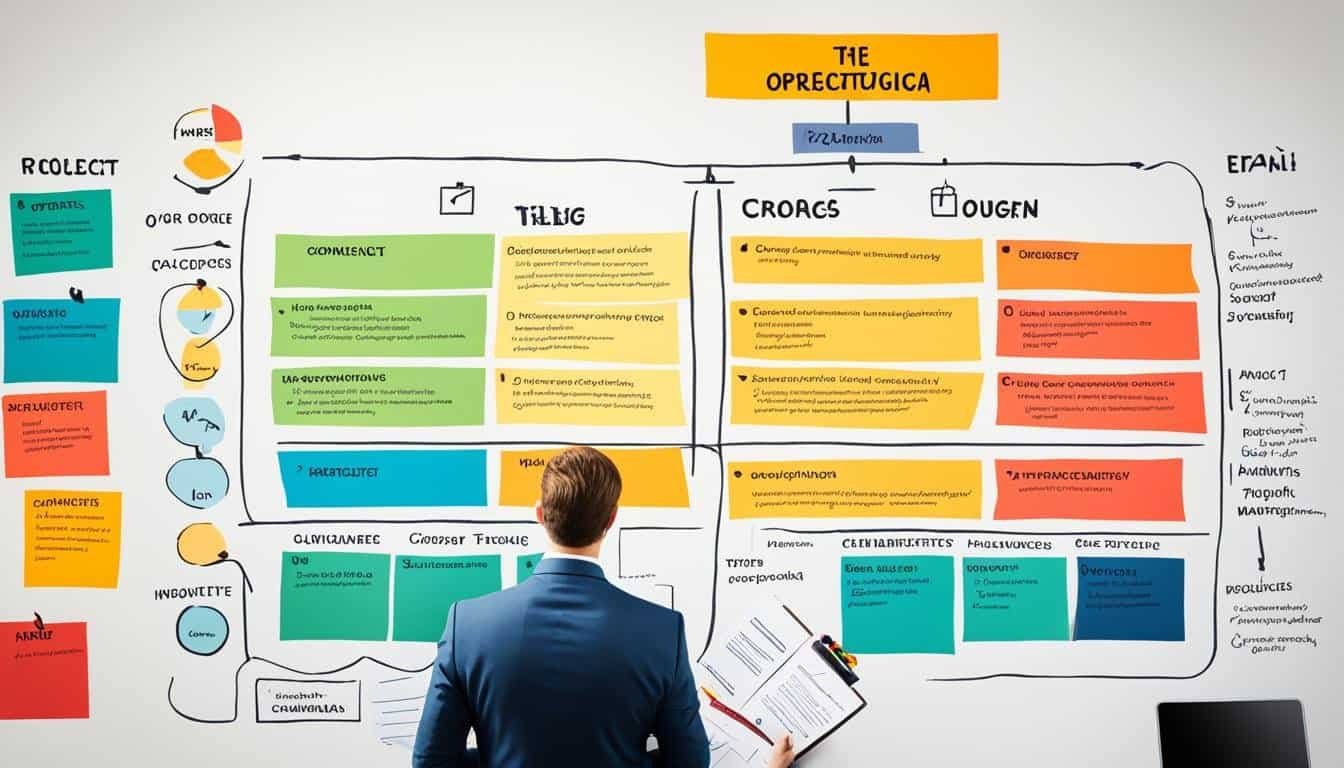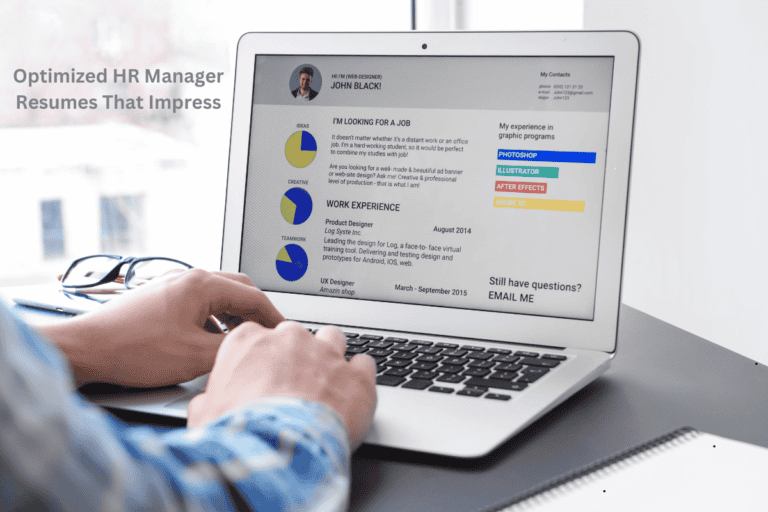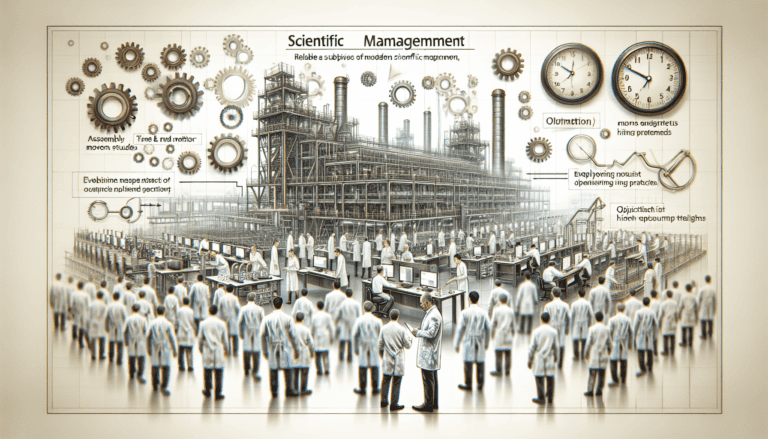Project Managers: Key Goals and Objectives
Welcome to our article on the key goals and objectives for project managers. Effective project management is essential for driving success in any organization, and project managers play a crucial role in achieving desired outcomes. By setting clear goals and objectives, project managers can establish a roadmap for success and guide their teams towards project completion.
A project management goal is the desired business outcome that the project aims to achieve. Objectives, on the other hand, are the specific actions and tasks that the project team undertakes to move closer to the goal. It’s important for project managers to set SMART goals – ones that are Specific, Measurable, Achievable, Relevant, and Time-bound. These goals provide clarity and direction, allowing project managers to effectively plan and execute projects.
In this article, we will explore the difference between goals and objectives in project management, the importance of setting SMART goals, and provide actionable examples of project management goals. We will also discuss key areas where project managers need to focus, such as meeting deadlines, controlling budgets, improving team collaboration, and more.
Key Takeaways:
- Project managers play a crucial role in driving project success.
- Setting SMART goals is important for effective project planning.
- Goals define the desired business outcomes, while objectives outline the specific actions to achieve those goals.
- Some key areas for project managers include meeting deadlines, controlling budgets, and improving team collaboration.
- By focusing on key goals and objectives, project managers can enhance their performance and deliver successful projects.
Understanding the Difference: Goals vs. Objectives in Project Management
In project management, goals define the general intentions and ambitions of the business, while objectives are the precise actions taken by the project team to achieve those goals. Goals focus on the desired business outcomes, while objectives outline the specific tasks and actions required to reach those goals. By understanding the difference between goals and objectives, project managers can effectively set and achieve their project management goals.
Goals in project management provide a broad vision of what the project intends to achieve. They are the big-picture aspirations that align with the strategic objectives of the organization. For example, a goal could be to increase market share, launch a new product, or improve customer satisfaction.
On the other hand, objectives are the specific actions and tasks that need to be accomplished to fulfill the goals. They are SMART (Specific, Measurable, Achievable, Relevant, and Time-bound) and establish a clear roadmap towards the desired outcomes. Objectives can include tasks such as conducting market research, developing a marketing strategy, or implementing a customer feedback system.
Goals without objectives are just dreams. Objectives without goals are just tasks.
By distinguishing goals from objectives, project managers can effectively plan and execute their projects. Goals provide the direction and purpose, while objectives ensure a focused and actionable approach to achieve those goals. This clear delineation helps project managers prioritize tasks, allocate resources, and track progress, ultimately leading to successful project delivery.
Why Understanding the Difference Matters
Understanding the difference between goals and objectives is crucial in setting and achieving project management goals. When project managers can clearly define the broader goals and translate them into specific objectives, they can:
- Develop a well-defined project scope and deliverables
- Create a realistic project timeline and milestones
- Allocate resources effectively and efficiently
- Monitor and track progress towards the desired outcomes
- Evaluate the success and impact of the project
By clearly outlining goals and objectives, project managers can align their teams, stakeholders, and project sponsors towards a common purpose. This clarity and focus enhance decision-making, improve communication, and enable project teams to work cohesively towards achieving project success.
Setting SMART Goals in Project Management
Setting goals is a crucial aspect of project management, as it provides a clear direction and focus for the project team. In order to set goals that are effective and achievable, project managers can use the SMART goal-setting method. SMART stands for Specific, Measurable, Achievable, Relevant, and Time-Bound.
Specific: Goals should be clear and specific, leaving no room for ambiguity. Instead of setting a generic goal like “improve customer satisfaction,” project managers should define a specific outcome, such as “increase customer satisfaction rating by 10%.”
Measurable: Goals need to be measurable so progress can be tracked. This involves defining metrics or key performance indicators (KPIs) that can be quantified. For example, instead of setting a goal to “improve team collaboration,” project managers can set a measurable goal like “increase the number of cross-functional team projects by 20%.”
Achievable: Goals should be realistic and attainable. Project managers need to consider available resources, constraints, and limitations when setting goals. It’s important to set goals that challenge the team but are still within reach. For instance, instead of aiming to “double sales revenue in one quarter,” a more achievable goal could be “increase sales revenue by 20%.”
Relevant: Goals should align with the overall project strategy and be relevant to the project’s objectives. Project managers need to ensure that the goals are meaningful and contribute to the success of the project. For example, if the project’s main objective is to launch a new product, a relevant goal could be “conduct market research to identify customer preferences and tailor the product accordingly.”
Time-Bound: Goals should have a clear deadline or timeframe. This ensures that there is a sense of urgency and accountability for achieving the goals. By setting a specific timeframe, project managers can better plan and allocate resources. For instance, instead of setting a goal to “improve customer service,” a time-bound goal could be “reduce customer response time to inquiries by 50% within six months.”
Setting SMART goals in project management provides a structured approach to goal setting that helps project managers and teams stay focused, motivated, and accountable. By following the SMART framework, project managers can ensure that their goals are well-defined, measurable, attainable, relevant, and time-bound, leading to greater project success.
10 Actionable Examples of Project Management Goals
Implementing effective project management goals is crucial for project managers to drive performance and success. Here are 10 actionable examples of project management goals that project managers can implement:
- Meeting Deadlines and Finishing Projects on Time: Ensure all project milestones are met and projects are completed within the scheduled time frame.
- Controlling Project Budgets and Expenses: Monitor and manage project budgets to avoid cost overruns and ensure efficient resource allocation.
- Improving Team Collaboration and Communication: Foster seamless collaboration and open communication among team members to enhance productivity and project outcomes.
- Increasing Team and Project Productivity: Implement strategies to enhance team efficiency, streamline workflows, and maximize project productivity.
- Ensuring Stakeholder Satisfaction and Engagement: Focus on meeting stakeholder expectations and actively involving them throughout the project lifecycle to ensure their satisfaction and engagement.
- Optimally Utilizing Project Resources: Efficiently allocate and manage project resources, including time, budget, and personnel, to optimize project outcomes.
- Making Team Meetings More Effective: Enhance the effectiveness of team meetings by setting clear objectives, facilitating active participation, and promoting productive discussions.
- Building a Data-Driven Culture: Leverage data analytics and insights to make informed decisions, track project performance, and drive continuous improvement.
- Simplifying Collaboration and Communication with Clients: Streamline communication and collaboration processes with clients to foster strong relationships and ensure seamless project execution.
- Keeping Up with New Trends and Technologies: Stay updated with the latest trends and advancements in project management to adapt and leverage new technologies for enhanced project performance.
Implementing these project management goals covers various aspects of project management and can have a significant impact on overall project success.
Meeting Deadlines and Finishing Projects on Time
Meeting deadlines and finishing projects on time is a critical goal for project managers as it ensures the successful delivery of projects. To achieve this objective, project managers need to focus on effective time management and closely track the progress of tasks.
One of the key aspects of meeting deadlines is identifying critical tasks that have the potential to cause delays. By pinpointing these tasks early on and allocating appropriate resources, project managers can mitigate potential bottlenecks and maintain project momentum.
Furthermore, it is essential to properly manage task dependencies, ensuring that all interdependent activities are well-coordinated. This allows project managers to anticipate any potential delays arising from dependencies and take proactive measures to mitigate their impact.
Project managers can leverage task management tools to streamline the tracking of task progress, dependencies, and milestones. These tools provide real-time visibility into project status, enabling project managers to stay on top of timelines and make informed decisions.
“Meeting deadlines is not just about monitoring time; it’s about orchestrating tasks, balancing resources, and adapting to unexpected challenges.”
Benefits of Meeting Deadlines and Finishing Projects on Time
Meeting deadlines and finishing projects on time offers several advantages:
- Enhanced client satisfaction and trust
- Improved project team morale and motivation
- Reduced risks associated with schedule delays
- Increased overall project efficiency and productivity
- Improved reputation for delivering on commitments
By prioritizing the goal of meeting deadlines and finishing projects on time, project managers can drive project success and contribute to the long-term growth of their organizations.
| Challenges | Solutions |
|---|---|
| Lack of clear task prioritization | Establish clear prioritization criteria based on project objectives and stakeholder needs. |
| Inadequate resource allocation | Ensure proper resource planning and allocation to account for project requirements. |
| Poor communication and collaboration | Use collaborative tools and establish effective communication channels for seamless coordination. |
| Unclear dependencies and task interdependencies | Map out task dependencies and proactively manage potential bottlenecks to avoid delays. |
| Inaccurate time estimation | Leverage historical data and utilize task tracking tools to improve time estimation accuracy. |
Controlling Project Budgets and Expenses
Controlling project budgets and expenses is vital for the success of any project. By effectively managing project costs and making informed decisions, project managers can ensure that projects are delivered within budget. Tracking project expenses, adjusting the budget as needed, and identifying cost escalation during project execution are key aspects of budget control.
Project managers need to manage resources wisely in order to control project budgets. This involves carefully allocating funds, monitoring expenditures, and making necessary adjustments to avoid budget overruns. By keeping a close eye on project expenses, project managers can identify areas where costs can be reduced or optimized, enabling them to deliver projects within the allocated budget.
Effective budget control is essential for better financial management and project success. It allows project managers to allocate resources efficiently, minimize financial risks, and make strategic decisions that align with the project’s financial objectives. By prioritizing budget control, project managers can ensure that resources are utilized optimally and projects are delivered within budget constraints.
Importance of Controlling Project Budgets
Controlling project budgets is crucial for several reasons:
- Financial stability: By keeping project expenses in check, project managers contribute to the financial stability of the organization. Budget control helps prevent overspending, reducing the risk of financial strain.
- Resource optimization: Effective budget control allows project managers to allocate resources efficiently. By avoiding unnecessary expenditures and optimizing resource utilization, projects can achieve maximum efficiency and productivity.
- Cost management: Controlling project budgets enables project managers to identify and manage costs effectively. This includes monitoring expenses, identifying cost-saving opportunities, and making informed decisions to minimize financial risks.
- Client satisfaction: Delivering projects within budget not only benefits the organization but also enhances client satisfaction. Clients appreciate projects that meet financial expectations, reinforcing trust and fostering strong relationships.
By prioritizing budget control, project managers can ensure financial stability, optimize resource utilization, manage costs efficiently, and enhance client satisfaction.
Strategies for Controlling Project Budgets
Here are some strategies that project managers can employ to effectively control project budgets:
- Thoroughly assess project costs: Conduct a comprehensive analysis to estimate project costs accurately. Consider factors such as labor, materials, equipment, and any external services required. This ensures that the budget is aligned with the project’s financial requirements from the outset.
- Implement cost-tracking mechanisms: Utilize project management software or other tools to track expenses in real-time. This allows project managers to monitor costs closely, identify potential budget overruns early on, and take corrective actions promptly.
- Regularly review and update the budget: Continuously evaluate the budget and make adjustments as necessary. This includes reassessing project requirements, accommodating unforeseen expenses, and reallocating funds to critical areas that require additional resources.
- Engage stakeholders: Involve stakeholders in the budget control process by communicating financial updates and seeking their input. By keeping stakeholders informed and engaged, project managers can gain support for necessary budget adjustments and maintain transparency throughout the project.
- Risk management: Identify potential financial risks that could impact the project budget. Develop contingency plans and allocate reserves to mitigate these risks effectively. Regularly assess and monitor risks to ensure that the budget remains on track.
By implementing these strategies, project managers can effectively control project budgets, mitigate financial risks, and ensure the successful delivery of projects within budget constraints.
| Benefits of Controlling Project Budgets | Strategies for Controlling Project Budgets |
|---|---|
|
|
Improving Team Collaboration and Communication
Team collaboration and communication are crucial for project success. Effective collaboration ensures that team members work together harmoniously, leveraging their diverse skills and perspectives to achieve project goals. Additionally, efficient communication promotes transparency, clarity, and alignment among team members, enabling them to better understand project requirements and effectively address challenges.
To improve team collaboration, project managers should:
- Establish a culture of open and transparent communication, where team members feel comfortable sharing ideas, concerns, and feedback.
- Utilize project management software with collaborative features to facilitate communication and enhance teamwork. These tools allow team members to share files, track progress, and collaborate in real-time.
- Schedule regular team meetings to discuss project updates, address concerns, and foster a sense of unity among team members.
- Set clear agendas for meetings, ensuring that discussions remain focused and productive.
- Encourage active participation and engagement from all team members to maximize input and generate innovative solutions.
- Utilize tools such as instant messaging or video conferencing to facilitate quick and efficient communication, especially for remote or distributed teams.
“Effective collaboration is the cornerstone of successful project execution. When team members collaborate effectively, they can leverage their individual strengths, solve problems collectively, and achieve remarkable results.”
– Richard Branson
By implementing these strategies, project managers can improve team collaboration and communication, fostering a collaborative environment where every team member feels valued and supported. This ultimately leads to improved project outcomes and a higher level of satisfaction among team members.
Enhancing Team Collaboration with Project Management Software
To further enhance team collaboration, project managers can leverage the capabilities of project management software. These tools provide features such as:
- File sharing: Team members can easily share and access project-related documents, ensuring everyone has the necessary information.
- Task and milestone tracking: Project management software allows the team to track task progress, deadlines, and milestones, ensuring alignment and accountability.
- Discussion boards and comment sections: These features facilitate ongoing communication, enabling team members to ask questions, provide feedback, and collaborate on specific tasks or issues.
- Real-time updates: Project management software provides real-time updates on project progress, allowing team members to stay informed and adapt their work accordingly.
- Centralized project documentation: All project-related files, documents, and communication are stored in one centralized location, making it easy for team members to find the information they need.
By utilizing project management software, project managers can streamline collaboration, enhance communication, and effectively manage project workflows. This ultimately leads to improved project outcomes and a more cohesive and productive team.
Increasing Team and Project Productivity
Productivity is a top concern for project managers. In order to improve project outcomes and ensure success, it is crucial to focus on increasing team and project productivity. By implementing productivity tools and solutions, such as project management software, project managers can streamline workflows, centralize project information, and enhance team coordination.
Project management software offers a range of features and functionalities that can significantly improve productivity. These tools provide a centralized platform for project planning, task management, and collaboration. Team members can easily track their tasks, update progress, and communicate with each other, leading to improved efficiency and productivity.
One of the main advantages of using project management software is the ability to streamline workflows. With automated processes and seamless integration, project managers can reduce manual efforts, eliminate bottlenecks, and ensure smooth project execution. This allows team members to focus on their core tasks and deliver work more efficiently.
Moreover, project management software enables project managers to have better visibility and control over project progress. Real-time dashboards and reporting features provide valuable insights into project status, resource utilization, and milestone achievements. This helps project managers identify areas of improvement and take proactive measures to optimize productivity.
Benefits of Using Project Management Software for Increasing Productivity:
- Improved task management and organization
- Enhanced collaboration and communication
- Efficient resource allocation and tracking
- Streamlined project documentation and file management
- Centralized project information and real-time updates
- Greater visibility and control over project progress
“Project management software offers a range of features and functionalities that can significantly improve productivity.”
By embracing project management software and leveraging its capabilities, project managers can effectively manage complex projects, improve efficiency, and ensure all team members are aligned and working towards project goals. With the right tools in place, project productivity can be maximized, leading to successful project outcomes.
| Strategies to Increase Team and Project Productivity | Description |
|---|---|
| 1. Set Clear Goals and Priorities | Clearly define project goals, milestones, and priorities to guide the team’s efforts and ensure everyone is aligned. |
| 2. Delegate Tasks Effectively | Assign tasks based on individual strengths and expertise, ensuring each team member has a clear understanding of their responsibilities. |
| 3. Monitor Progress Regularly | Keep track of task progress, milestones, and deadlines to identify potential bottlenecks and take necessary actions to keep the project on track. |
| 4. Foster Collaboration and Communication | Promote open communication channels, encourage collaboration, and provide tools that facilitate efficient communication among team members. |
| 5. Streamline Processes and Workflows | Identify redundant or inefficient processes and streamline them to eliminate unnecessary delays and improve overall workflow efficiency. |
Implementing these strategies, along with the use of project management software, can significantly improve team and project productivity. By focusing on optimizing productivity, project managers and their teams can drive successful project outcomes and deliver results effectively.
Ensuring Stakeholder Satisfaction and Engagement
Stakeholders play a crucial role in the success of any project. As a project manager, it is vital to focus on meeting and exceeding stakeholder expectations, engaging stakeholders throughout the project lifecycle, and ensuring regular communication and feedback. By doing so, project managers can build trust, establish transparency, and deliver value that leads to stakeholder satisfaction.
Engaging stakeholders from the beginning allows project managers to gain valuable insights and input, ensuring that the project aligns with their needs and expectations. Regular communication channels, such as meetings, emails, and progress reports, help keep stakeholders informed about project updates, milestones, and any changes that may occur. Soliciting feedback and addressing concerns in a timely manner demonstrates the project manager’s commitment to stakeholder satisfaction.
“Effective stakeholder engagement is the key to project success. By actively involving stakeholders in the decision-making process, project managers can leverage their expertise and ensure inclusivity, resulting in better project outcomes.”
Transparency is another crucial aspect of stakeholder satisfaction. Project managers should provide stakeholders with clear and accurate information about the project’s progress, challenges, and risks. Transparency helps foster trust and ensures stakeholders have realistic expectations throughout the project’s lifecycle.
To deliver value to stakeholders, project managers should prioritize their needs and align project objectives accordingly. By understanding stakeholders’ priorities, preferences, and desired project outcomes, project managers can make informed decisions that cater to their needs.
Benefits of Stakeholder Satisfaction and Engagement
Ensuring stakeholder satisfaction and engagement brings several benefits to project management:
- Enhanced project outcomes: Engaged stakeholders provide valuable insights and collaborate effectively, leading to improved project results.
- Reduced risks: By staying connected with stakeholders, project managers can identify risks early and take proactive measures to mitigate them.
- Improved communication: Engaging stakeholders ensures clear and effective communication, reducing misunderstandings and conflicts.
- Increased stakeholder support: Satisfied stakeholders are more likely to support and advocate for the project, leading to a greater likelihood of success.
By prioritizing stakeholder satisfaction and engagement, project managers can create a collaborative and positive project environment that attracts and retains stakeholder support, ultimately contributing to the success of the project.
Optimally Utilizing Project Resources
Efficiently optimizing project resources is a crucial goal for project managers. By effectively allocating budget, time, and people, project managers can ensure the smooth progress and successful completion of projects. This goal requires strategic planning and coordination to achieve the desired project objectives.
Resource management plays a vital role in project success. It involves identifying and prioritizing the necessary resources, allocating them appropriately, and monitoring their utilization throughout the project lifecycle. By optimizing project resources, project managers can maximize productivity, minimize costs, and enhance overall project performance.
Optimizing project resources involves several key actions:
- Identifying resource requirements: Project managers need to thoroughly analyze project requirements and identify the specific resources needed to achieve project goals. These resources may include skilled personnel, equipment, software, or other necessary materials.
- Allocating resources effectively: Once the resource requirements are identified, project managers must allocate resources appropriately. This involves assigning tasks to team members with the required skills and expertise, ensuring that the workload is distributed evenly, and considering any dependencies or constraints.
- Managing resources efficiently: Project managers should continuously monitor resource utilization and manage workloads effectively. This includes avoiding overloading team members, addressing any bottlenecks or conflicts in resource allocation, and making adjustments when necessary to ensure optimal resource utilization.
- Optimizing time management: Time is a valuable resource in project management. Project managers should prioritize tasks, establish realistic deadlines, and implement effective time management strategies to avoid delays and optimize project timelines.
By optimizing project resources, project managers can enhance project efficiency, reduce wastage, and improve overall project outcomes. Effective resource management leads to better utilization of available resources, cost savings, and a higher likelihood of project success.
Making Team Meetings More Effective
Team meetings are a vital component of successful project management. They provide an opportunity for project coordination, collaboration, and effective communication among team members. However, without proper planning and execution, team meetings can become unproductive and time-consuming.
To improve the effectiveness of team meetings, project managers should set specific goals and strategies. Here are some key steps to achieve more efficient and productive team meetings:
- Establish clear meeting agendas: Before each meeting, create a detailed agenda outlining the topics to be discussed and the goals to be achieved. This helps team members prepare in advance and ensures that the meeting stays focused and on track.
- Reduce the frequency of meetings when possible: Evaluate the necessity of recurring meetings and consider alternatives such as email updates or shorter check-in sessions. This allows team members to dedicate more time to project-related tasks.
- Encourage active participation: Foster a collaborative environment where everyone feels comfortable sharing their ideas, concerns, and progress updates. Encourage open discussions and actively engage team members in decision-making processes.
- Utilize collaboration tools: Leverage technology to enhance meeting efficiency. Use project management software or communication platforms that allow real-time collaboration, document sharing, and task management.
By implementing these strategies, project managers can transform team meetings into productive sessions that drive project progress and success. Effective team meetings improve communication, increase collaboration, and foster a sense of accountability among team members.
Remember: The key to making team meetings more effective is to plan ahead, create a focused agenda, and foster active participation. By maximizing the value of these meetings, project managers can enhance team productivity and ultimately achieve project goals.
Building a Data-Driven Culture in Project Management
A data-driven approach has become increasingly essential in project management, allowing project managers to make informed decisions and drive success. By leveraging data analytics and incorporating data into decision-making processes, project managers can achieve more accurate predictions, identify trends, and mitigate risks.
Data-driven project management involves incorporating key performance indicators (KPIs) and metrics into project monitoring and evaluation. By tracking these metrics, project managers can gain valuable insights into project performance and make data-backed decisions to ensure project success.
Benefits of Using Data in Project Decision-Making
Using data in project decision-making offers numerous advantages:
- Improved Accuracy: Data-driven decision-making reduces reliance on assumptions and guesswork, leading to more accurate project planning and execution.
- Identifying Trends and Patterns: Analyzing data enables project managers to identify trends and patterns that can inform future strategies and tactics.
- Risk Mitigation: By analyzing data, project managers can identify potential risks and take proactive measures to mitigate them.
- Enhanced Resource Allocation: Data insights help project managers allocate resources effectively, ensuring optimal utilization and avoiding bottlenecks.
Making data-driven decisions requires project managers to establish robust data collection processes and invest in data analytics tools. By embracing a data-driven culture, project managers can elevate their decision-making capabilities and drive project success.
| Data-Driven Project Management | Traditional Project Management |
|---|---|
| Decisions based on data insights and analytics | Decisions based on subjective assessments and experience |
| Rapid identification and response to project issues | Delayed identification and response to project issues |
| Proactive risk mitigation | Reactive risk management |
| Improved resource allocation | Suboptimal resource allocation |
Table: Contrasting Data-Driven Project Management with Traditional Project Management
A data-driven culture in project management encourages continuous improvement and helps teams stay agile and adaptive. By embracing data, project managers can unlock the full potential of their projects, making better-informed decisions and achieving greater success.
Summary of Key Goals and Objectives for Project Managers
Project managers play a vital role in driving project success. By setting and achieving key goals and objectives, project managers can enhance their performance, improve project outcomes, and contribute to the overall success of their organizations.
The key goals and objectives for project managers encompass a wide range of areas. First and foremost, meeting deadlines is critical to ensure timely project completion. Additionally, controlling budgets effectively helps keep projects within financial constraints. Furthermore, improving team collaboration and communication fosters a cohesive and productive work environment.
Increasing team and project productivity is another important focus for project managers. Ensuring stakeholder satisfaction and engagement is essential for a successful project outcome. Optimally utilizing project resources, making team meetings more effective, and building a data-driven culture are also key objectives. Moreover, simplifying client collaboration and staying up-to-date with new trends in project management contribute to project managers’ success.
By placing emphasis on these goals and objectives, project managers can excel in their roles, overcome challenges, and deliver successful projects that meet stakeholder expectations.







